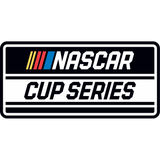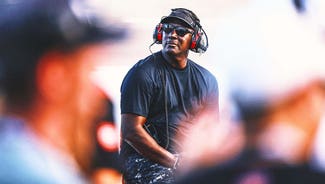
NASCAR's lack of parity remains obvious
As predicted, this could shape up to be one of NASCAR’s closest and most competitive championship races in years.
Two races into the Chase for the Sprint Cup, it looks as if eight to 10 teams could be legitimate contenders. Though Denny Hamlin has maintained a 35-point lead, four-time champion Jimmie Johnson closed the gap with his win at Dover Sunday and eight drivers are within 83 points of one another.
Though Hamlin, Johnson and third-place Kyle Busch still could pull away and make it a two- or three-team race, chances are Kevin Harvick, Carl Edwards and Jeff Gordon will have something to say about that.
When it comes to parity, NASCAR’s top drivers are keeping the series competitive.
There have been 12 different winners so far this year, which is comparable to the last three seasons, when there were from 12 to 16 different winners.
But when it comes to teams and organizations, there continues to be a wide gap between the haves and have-nots, particularly when it comes to winning the Chase and the series championship.
When it comes to NASCAR’s most prestigious title, there is little equality among the organizations fielding teams and cars.
Hendrick Motorsports has won the past four series championships and with Johnson and Gordon in the mix again this season, stands a good chance to make it five straight.
The best bet to unseat them is Joe Gibbs Racing, which has Hamlin and Kyle Busch in the mix. Gibbs has won three Cup titles since 2000.
And don’t count out Roush Fenway Racing, which won the inaugural Chase in 2004 and also the last championship (2003) under the old season-long points race.
Those are the only three organizations that have won championships under the Chase format and that have won titles since 2000.
In fact, those three teams have ruled the NASCAR Cup landscape for the past 15 years.
Since 1994, Hendrick has won nine championships, including four straight on two different occasions (1995-98 and 2006-09).
The only teams that have broken the Hendrick stranglehold have been Gibbs (2000, 2002, 2005), Roush (2003-04) and Robert Yates Racing, which won it in 1999.
That’s four championship organizations in 15 years. And though eight different drivers and teams have won those titles, it’s clear that NASCAR’s top series has been dominated by a handful of organizations.
Ironically, one of the operations trying to stop Hendrick’s dominance and enter that elite group this season is the team that was dominating the series before Hendrick’s rise to the top 16 years ago.
Richard Childress Racing, which has three drivers in the Chase and one of the favorites in Harvick, hasn’t won a Cup title since Dale Earnhardt’s last championship in 1994.
Prior to that, though, RCR was the sport’s dominant team, winning six titles in nine years.
It seems that NASCAR has always had a dominant organization, or at least a handful of elite teams, but shouldn’t there be a bit more parity among Cup teams in what is supposed to be its most competitive era?
This year’s 12 Chase drivers come from just six different organizations, with Roush and RCR putting three drivers each in the championship race. Hendrick and Gibbs each have two while Penske Racing and Stewart-Haas Racing have one each, though Stewart-Haas is closely affiliated with Hendrick.
That’s down from last year, when eight different teams had drivers make it, including Earnhardt Ganassi Racing, Richard Petty Motorsports and Red Bull Racing, which were all shut out this year.
Though Earnhardt Ganassi and RPM were both in Chase contention this year, the dwindling number of teams in the 10-race playoff could be a sign that the gap between the top organizations is once again widening.
NASCAR has taken steps in recent years to try to close that gap and make its top series more competitive.
It’s no-testing policy, new car, team-cap rule and other cost-containment initiatives were all implemented with the hope of making the series more competitive and giving more teams a chance to win and contend.
Instead, those changes have made little impact on the competition front.
The testing ban has given the top teams a bigger advantage because they have more resources and better technology to simulate race conditions and develop cars and set-ups. With no testing on NASCAR-sanctioned tracks and fewer resources, smaller teams have less of a chance of catching up.
The same scenario has played out with the new car. The bigger, better and better-funded teams simply have adapted easier and figured the new car out quicker.
The new car was implemented full time in 2008. In 2008-09, Hendrick, Roush and Gibbs combined to win 54 of 72 points races. They have won 16 of 28 so far this season.
The downturn in the economy also has not helped, as the top, most successful teams have had more success maintaining and attracting sponsors.
They also continue to corner the market on the sport’s top drivers. Not only did Hendrick sign and develop Gordon and Johnson, but also lured veteran star Mark Martin into the fold two years ago and already has signed talented Kasey Kahne for 2012.
Joe Gibbs built his team around Bobby Labonte and Tony Stewart but developed Hamlin and Joey Logano and won a bidding war for Kyle Busch when he left Hendrick.
Roush has simply reloaded over the years, replacing Martin and Jeff Burton with Kenseth, Greg Biffle, Kurt Busch (who is now at Penske) and Edwards.
RCR signed and developed Harvick and Clint Bowyer and landed Burton when he left Roush.
Those organizations and teams win because they have the top drivers. And those drivers win because they are with top teams and top organizations.
It’s a vicious cycle that is very difficult to break, even for well-run teams like Penske, Earnhardt Ganassi and Michael Waltrip Racing.
So what can NASCAR do?
Short of tightening its team-cap rule — reducing it from four to three or even two teams — not much.
As long as Hendrick, Gibbs, Roush and RCR are able to afford and attract the top drivers, employees and sponsors, the rich will only get richer, leaving only scraps and a glimmer of hope for the rest.

